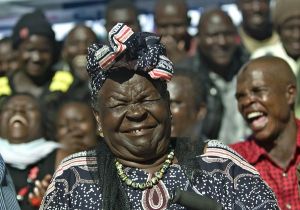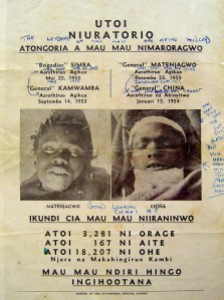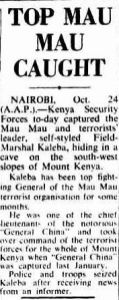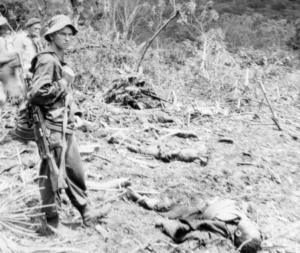The 1950s are Kenya’s curse.
No one cared to correct the myths because they fit into a certain context which romanticized the Mau Mau while keeping them subjugated to their new lords. While they died off in abject poverty and a society that blamed them for Operation Anvil, a different set of myths took root and became the mainstream stories…
Oh, and the tale of pseudo-gangs is not comprehensively explained on this list but you might want to ask your grandparents which Mau Mau exactly they really were on by the end of the rebellion.
#6 MAU MAU? Mau Mau? Mau?
Basic Kenyan history huh? You could answer this one while overlapping and texting on the phone and not endanger anyone on either lane, right? Well…what we have are ideas, guesses, too many to be sure it seems like we forgot to ask Sir Evelyn Baring’s predecessor before he left.
Dedan Kimathi’s assertion in the KFLA Charter notes that the ‘Mau Mau’ was a synonym for terrorists and that the movement was called the Kenya Freedom (and) Land Army (KFLA). If it was propaganda (and quite effective, given that it is now a brand and a term used to indicate brutality), where did it come from in the first place? It clearly has roots in some African language, more so Bantu, but which one and/or why?
The group originally called itself muingi [masses];Other possible sources of the common name include the Movement of Unity, the Kikuyu Maranga African Union (KMAU); or, as Bildad Kaggia claimed, the secret code muhimu. Some accounts even claim that the name could have been taken from the Mau, the range of Mountains in the Rift Valley. In 1963, another claim emerged, this time arguing that young Kikuyu boys would say Uma Uma [Get out! Get Out!] during initiation.
Another myth (well, I warned you there are many) 2claims that it came from the first ever prosecution of a member of the Mau Mau, that of Magroui Ole Kedogoya, for attempting to recruit his supervisor into a secret society. He allegedy said (as quoted in Kinyatti, 1992) ndingikwira maundu mau mau nderirwo ni kiama.[ I cannot tell you those, those things that I was told not to tell you by the movement.] This version claims that the wide coverage of the case by the colonial press grasped the words mau mau (those, those) and assumed they meant the secret movement.The group later made due with the brand as Mzungu Aende Ulaya. Mwafrika Apate Uhuru (No, not that Uhuru, the feudal prince one, although come to think of it….)
There is one other plausible source
It is likely that the name came from a mishearing of a Kikuyu or Swahili word, and ‘muuma’ seems like the most likely candidate. Some factions of the freedom fighters refered to the movement as ‘Muuma wa Uiguano’ (Oath of Unity). Could it be that the loyalists, in attempting to explain what the Mau Mau oath was and why it was so strong, never noticed that the British colonial government heard something completely different and seemingly retarded?
The name itself was not exactly unique as it formed part of Sojourner Truth’s mother’s nickname ‘Mau-Mau Bett.’ Truth’s mother was an enslaved African from Guinea. She (Sojourner) died in 1883.
#5 Obamas Grandfather
In Dreams from My Father, Barrack Obama claims that his grandfather was detained and tortured by the British. Sarah Obama, according to multiple accounts, says that when he came home he was thin, dirty, and injured. Hussein Obama had (supposedly) been supplying weapons and information to the freedom fighters.
Sarah has further been quoted as saying that Mzee Obama’s testicles were pressed and he had been whipped by his African oppressors twice a day…because, of course, the British and their cronies had an unhealthy obsession with pliers and testicles. Obama claims in his book that his grandfather was held for 6 months, and Sarah claims he was held for 2 years, it was the 1940s/50s anyway, time was a blur…
The only would-be corroboration for this story is that of Tim Symonds (3rd Last Paragraph) where he says
“During one mission in the bamboo forest he captured a 50 or 60-year-old insurgent named Obama who spoke perfect English. That is clearly not a Kikuyu name and Tim has written to the American Embassy trying to discover if this was the grandfather of U.S. President Obama.”
Why it’s BS
An Obama biographer, David Maraniss critically assessed this claim and came out with nought; he got multiple accounts from Hussein Obama’s friends who worked with him and who noted would obviously have known. There is also the curious fact that at the time when Obama the Elder was supposedly in prison, his son, Obama Sr. (father to the current POTUS) was studying at Maseno National School (1950-1953).
It is likely that Obama was a friend of the founders of the group, then running the militant wing of the KCA, the Group of 40 but it is unlikely that Obama ever became an active member of the group. Tim Symonds’ story implies that Obama Sr. was an active fighter, a seeming discrepancy from the other myth that he was a secondary participant in the war…
One of Obama Sr’s daughters, Ayuma, gives a more logical explanation; that he had been kidnapped by thugs and the story had been weaved through generations to claim he was a freedom fighter.
#4 Lari Massacre, The Night of Long Knives
Kenya’s poster-child case of how a counter-massacre is the generally accepted response to a massacre.
On March 26th 1952, a group of Mau Mau fighters attacked and massacred entire families yanking children away from their mothers and hacking them to death. Anywhere between 70 and 100 people were brutally murdered in a single night including Chief Makimei and his predecessor, Luka Kihangara.
The counter-massacre began when the homeguards returned and found Luka’s, Makimei’s and other homes ablaze. As they gave chase to the fleeing Mau Mau fighters, they began a counter-massacre that eventually outdid the initial crime. Lari DC at the time, John Cumber, made the situation even worse when he ordered that all male suspects be rounded up (which, if the chronology of state massacres is anything to go by, means virtually any male in the vicinity).
In Volume 2A, Page 165/6/7, the TJRC report vividly explores the counter-massacre that made the first massacre look like a joke. The Commission refers to the massacre of the early hours of 27 March 1953 as “Little-known, little-discussed, little-acknowledged and yet undeniable...” Although almost all historical accounts hold that the 70 people died in the initial massacre, over 200 bodies were strewn all over Lari on the morning of 27 March. In the East African Standard report sometime after the massacre and counter-massacre, the government acknowledged having killed 150 people. This is generally agreed as the lower limit of the fatalities of the counter-massacre, and does not even include the over 70 people who were later hanged for the initial massacre.
The Lari Massacre of the loyalists and their families was just the one that received the most attention and the one which the Colonial government milked for propaganda. Photos of the initial massacre appeared on numerous pamphlets and news reports, and was used to show the Mau Mau as savages. I guess when you call dibs you must take all the blame…
#3 When the Mau Mau war ended
Officially, the actual war began to subside after Kimathi was captured in 1956. In truth, the Mau Mau war ended in 1963/4, and not without the characteristic massacre that the KE Government uses as a signature strategy to solve security issues.
The Meru faction of the insurgency survived the decade. Field Marshal Mwariama and General Baimungi (Peoples General) had been in contact with Kenyatta as early as 1962 when he (Kenyatta) gave Mwariama a 15-acre plot of land which was, in truth, a loan he and other similar recipients had to pay back. Baimungi went back to the forest in Jan 1964 with ‘200 fighters’ (referred to as thugs in this Times article). Mwariama is the dreadlocked man in the famous photos with Kenyatta. He was good PR.
At Ruringu Stadium in Nyeri, Mau Mau fighters including Field Marshal Muthoni, Kimathi’s ‘Weaver Bird’, surrendered their weapons to the government. FM Muthoni left the forest in 1963/4, according to her own account but was first cleaned up and dressed well. General Baimungi, clearly not a known-giver-of-fucks,and his group were massacred on 26th January 1964 and their bodies (Baimungi and Chui) paraded in Meru Town for three days.
The exact reasons of his refusal to surrender are unclear, G. G Kariuki here asserts the popular myth that he demanded that the Mau Mau be given control over the Kenya security forces. His wife,Evangeline Muthoni Baimungi, later said that he (Baimuingi) had been given a Land Rover by Kenyatta and a flag to fly on the car. He used the vehicle to transport about seven 20 kg containers full of cash he was holding in trust from the oathing fees. Mau Mau veterans agree there was cash, but argue instead that Baimungi used it to buy the Land Rover.
Very little is known about what happened to Mwariama, although this account tells us that he died in 1989 due to “…complications from snake venom he had sucked from the leg of a friend who was bitten during a visit to Ukambani” ; the man who enlisted both he and Baimuingi died in April 2013.
#2 Who was Field Marshal Kaleba?
I KNOW, you have also never heard of him have you? Neither had I when I first set out to research entries for this list.
To understand who Field Marshal Kaleba was, or was supposed to be, let’s first describe the Gray Leakey Murder, perhaps the most gruesome of all known assassinations during the course of the Emergency.
Arundel Gray Leakey, cousin to the more famous Louis Leakey, and known as ‘Morungaru’ was a white settler farmer in Central Province. He was the brother of Nigel Gray Leakey, a badass World War II soldier who jumped over an Italian tank and shot all its occupants except the driver. He (Nigel) was awarded the Victoria Cross, the highest award of gallantry that can be awarded to British and Commonwealth forces, albeit posthumously (he was killed when he tried the same stunt again).
In October 1954, the less accomplished Leakey’s home was attacked by 60+ Mau Mau freedom fighters who killed his wife and force marched him to the Mount Kenya forest. Almost all available accounts of his murder indicate that he was buried alive after being tortured and disemboweled. The murder was reportedly sanctioned as a human sacrifice to appease the spirits, but embarrassed the colonial government and forced it to look for a scapegoat.
A ‘Field Marshal Kaleba’ was the man the colonial government hanged for the gruesome crime. True to character, they paraded him before the media as a ‘Half-Kikuyu half-Somali’ who had led the murder and sacrifice of Gray Leakey. The link above claims that he was captured with two bodyguards, a girl, and most importantly, Gray Leakey’s revolver. Some just named him as a leader of the Mau Mau, although no corroborating evidence exists on who the man was.
So who was he? We know from multiple accounts that there were the only Field Marshals were Muthoni, Mwariama, and Kimathi. So, again, who was ‘Field Marshal Kaleba’? His real name was Gatici Kabutu although he was known in the ranks as Kaleba; history sources seem unsure as to his rank, but the best guess is General with Chui and Baimuingi. He had been caught earlier and then released to help in negotiations between the government and the freedom fighters, but he disappeared until the day he was caught.
#1 Mathenge, the Tragic Hero
Shenanigans!
A tale weaved over the course of fifty plus years, and hardly ever questioned, that General Stanley Mathenge led a band of fighters to Ethiopia in 1956 and never came back. Kimathi and Mathenge were something akin to rivalling siblings. Kimathi usurped power from the uneducated Stanley Matheng’e and declared himself Field Marshal while Mathenge remained a mere general despite being older and more experienced.
The competition led to the creation of two main ideological factions within the group, one which was aligned to Kimathi and was called ‘Kenya Parliament’ and another called ‘Kenya Riigi’ which had a less defined hierarchy but was led by Mathenge and Kahiu-Itina (Gen.)…and no, the last one did not get his name from stabbing people in the ass, he used to sheath his sword around his waist such that it rested on his buttocks.
By 1956, the ideals of the Mau Mau had pretty much changed from those of a war for freedom to a civil war. Waruhiu Itote and others had turned and were giving valuable information to the colonial government. The colonial government, through the pseudo gangs, reached out to Mathenge and the broader ‘Kenya Riigi’ to change the rules of engagement.

A typical pseudo-gang…
How long did it take you to notice that there is a white man in the photo?
www.psywar.org
General Kassam Gichimu Njogu gives a more plausible version of what really happened. Kimathi was pissed and ordered they (Mathenge and Kenya Riigi leaders) be court-martialed for treason. “Mathenge was bound with six fighters loyal to him to nearby trees as the court proceeded. A Wambui wa Nderitu from Mirangini in Nyandarua supposedly cut the ropes and Mathenge and his group ran into the forest.”
Two likely scenarios? Kimathi or the British government caught up with, and killed, Mathenge. It is unlikely that the British government did because, from what happened during Waruhiu Itote and Kimathi’s own capture and trials, they would have made it into a propaganda victory. This leaves only one ugly but more likely event, Kimathi’s side of the Mau Mau re-arrested and executed him and made sure his body was never found.
Kimathi had more to gain by portraying Mathenge as an uneducated coward who had abandoned the cause than by admitting he had had him killed. It was akin to a sibling fight for survival, and everyone lost, except in popular culture where Kimathi is almost deified and Mathenge tucked to an incomplete part of history. Somewhere in the Mount Kenya forests lie the remains of Stanley Mathenge and other prominent members of the Kenya Riigi.
War is peace.
Freedom is slavery.
Ignorance is strength.
George Orwell, 1984
Owaahh, 2013.
One story is good,
till Another is told.
Africa badassery Baimuingi Dedan Kimathi Kaleba Kenya Lari Massacre Mau Mau Musa Mwariama Operation Anvil Random Sarah Obama TJRC
Last modified: May 29, 2017




























